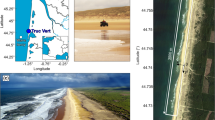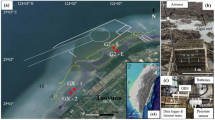Abstract
Within the Coastal Benthic Boundary Layer (CBBL) Program’s Key West Campaign, a series of complementary geophysical experiments were undertaken in the Lower Florida Keys. The primary objective was the collection of data to assist in the physical characterization of the sea-floor carbonate sediments. Digital subbottom profiler data collected along closely spaced lines were processed to produce maps of sea-floor reflectivity strength and variance. These were subsequently used to help map the spatial distribution of the Holocene sediment and to identify and delineate the outcropping Pleistocene limestones and Holocene patch reefs. Analysis of a complementary data set, comprised of shear wave velocities collected with a bottom-towed sled, provided additional valuable information on the physical characteristics of the soft silty sediments making up the surficial cover at the CBBL Program’s experimental tower site.
Similar content being viewed by others
Author information
Authors and Affiliations
Rights and permissions
About this article
Cite this article
Haynes, R., Huws, D., Davis, A. et al. Geophysical sea-floor sensing in a carbonate sediment regime. Geo-Marine Letters 17, 253–259 (1997). https://doi.org/10.1007/s003670050035
Issue Date:
DOI: https://doi.org/10.1007/s003670050035




